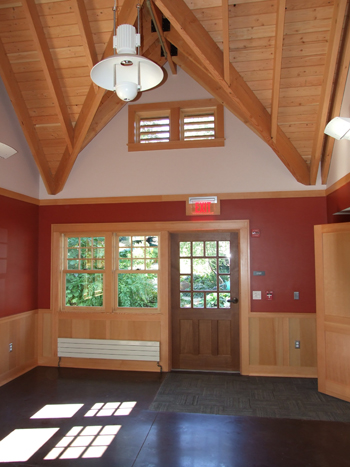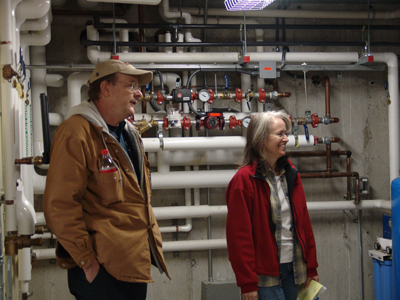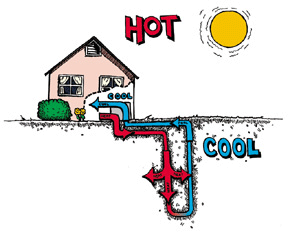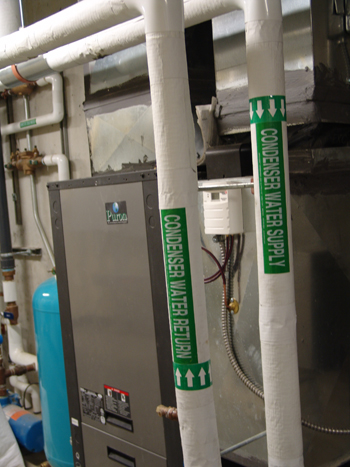Innovation

When designing a LEED-certified building there are many strategies such as storm water management techniques, recycling materials from construction, and maximizing the use of natural light to light the building, that will help accumulate points needed to receive LEED certification. In addition to these established and recognized practices, the certification process awards points for innovation. This ability to innovate new green designs and techniques is what is driving the continually evolving green industry.
Upon embarking on the design of the Wister Center, there was much discussion about the techniques and the associated costs for heating and cooling the building in a sustainable fashion. An idea garnering much support as a sustainable technique, but an expensive method, was a ground source heat pump system. The majority of the cost for this proposal was in the drilling of several 100-foot deep wells beneath the site to serve as an area for heat exchange.

Thomas Cochrane and Rhoda Maurer discuss the inner workings of the Wister Center. photo credit: R. Robert
Following one of these discussions, Swarthmore College’s Senior Project Manager for Mechanical Systems, Thomas Cochrane, was struck with an innovative idea which addressed the needs of the whole campus, not just the new Wister Center. Dubbed the Total Campus Perspective (TC system) by the project engineers, this design provides a synergistic solution that benefits the Wister Center and the campus as a whole.

Ground source heat pump system illustration from the International Ground Source Heat Pump Association.
Using the ground source heat pump system during the winter months, water is circulated beneath the earth’s surface through plastic pipes and where it is heated by the constant temperature of the earth (50 to 55 degrees). This heated water is carried back into the building to the heat the space. During the summer months, the system is reversed. The water pulls heat from the building where it is discharged into the cooler temperatures of the earth.
Thomas Cochrane recognized the existing chilled water loop on campus could provide a similar function as the earth in the ground source heat pump system for the Wister Center. During the winter months, the Wister Center can use excess heat collected from other locations on campus where cooling is occurring (such as computer rooms, electrical rooms, and mechanical rooms) to heat the building.
Tapping into the heated water from the chilled water loop on campus offsets the operation of the central plant chiller which would be responsible for chilling the water. According to the project engineering team, there is a savings of 1,639 ton-hours each winter season for the central campus chiller plant.

Mechanical room where the TC system is housed in the Wister Center. photo credit: R. Robert
During the summer, the Wister Center rejects heat to the return side of the chilled water loop with the MacCabe library cooling loads, where the Wister Center is connected to the campus chilled water loop. It is estimated this adds 1379 ton-hours each summer season to the central campus chiller plant. Thus the net impact on the central chiller plant is an annual savings of approximately 260 ton-hours.
In addition to these savings, there is an earth exchange component to the system. Six hundred and fifty feet of buried piping that connects MacCabe Library and the Wister Center, aid in transferring heat to the earth. Therefore, it is providing further reduction to temperature of the water circulating between buildings in the summer and increasing the temperature the water in the winter, again benefiting the load to the central campus chiller plant.
The engineers estimate this innovative system is a 39% improvement over traditional rooftop air unit systems and a 1% improvement over traditional ground-coupled heat pump systems. The TC system takes advantage of mechanisms already in place on campus to heat the new Wister Center and provide energy saving to the college as whole.





Jan Semler
Posted at 15:04h, 03 MarchNice job, Becky–a relatively simple explanation for this often confusing topic!
Becky Robert
Posted at 15:22h, 03 MarchThanks, Jan. This was a challenging topic to write about, but I want everyone to have a better understanding of the innovation of Tom and how we fit into the campus as a whole.